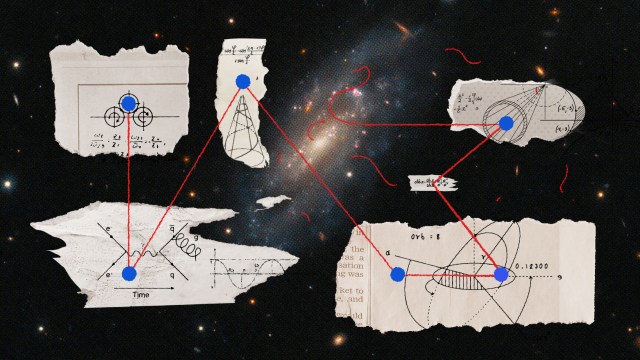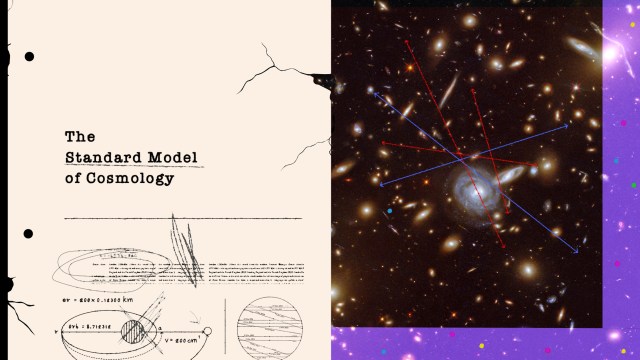Broken symmetry might break the standard model of cosmology

- There are four forces at work in the Universe — gravity, electromagnetism, the strong nuclear force, and the weak nuclear force.
- At the Big Bang, there was only one force. The forces split off as the Universe cooled.
- Our inability to find any evidence supporting the splitting of the electroweak force (into electromagnetism and the weak force) hints that something is missing. It is another sign that the standard model of cosmology might need a rethink.
The Universe is like a glass of water sitting in a freezer.
No, this is not a Zen koan. It is a metaphor rooted in the fundamental physics for how cosmic evolution, starting from the first instant after the Big Bang, is expected to proceed. In going from the ultra-hot, ultra-dense, ultra-smooth beginning that was the Big Bang to its current cold, clumpy state, the cosmos had to pass through a series of phase transitions, each akin to water solidifying into ice. And like water molecules locking into place as ice crystals, each cosmic phase transition had consequences for the structure of the Universe. Those consequences, it turns out, may be a big problem that our best cosmological models have not resolved.
Welcome to another installment in our series exploring emerging and potentially serious challenges to the standard model of cosmology — humanity’s best and most expansive scientific understanding of the Universe. In a recent paper, astrophysicist Fulvio Melia articulated a list of problems that to him indicate something fundamental is wrong with the standard model. Melia is not alone in wondering whether the standard model’s time might be up. Today we will take a look at another on Melia’s list of cosmological fault zones: the electroweak horizon.
Party of four
Physicists know that 13.8 billion years after the Big Bang, there are only four forces at work in the Universe: gravity, electromagnetism, the strong nuclear force, and the weak nuclear force. These four forces are the only way things can push or pull each other. Each force has its own characteristics, such as how far its effects can be felt, and each has its own strength relative to the other forces.
While the Universe has four forces now, most physicists believe that just after the Big Bang, when the temperature and energy density of the cosmos were much higher, there was but a single force. Only as the Universe expanded and cooled did this force separate into the four forces we know today. Physicists think these forces sequentially froze out from the initially unified force as the temperature dropped. Gravity froze out first, leaving the other forces mingled in a grand unified field. (All forces and all particles are associated with quantum fields.) The strong nuclear force froze out next, leaving electromagnetism combined with the weak force in the imaginatively named electroweak force. Finally, sometime around 10-11 of a second after the Big Bang, the electroweak force split apart as well.
While we still lack basic details about the gravity and strong force freeze-outs, the theory of the electroweak phase transition has been beautifully mapped out. It is where the all-important Higgs boson makes its appearance. The Higgs particle discovery at the Large Hadron Collider in 2012 was a triumph and a validation. It showed that we understand how the Universe went about breaking the single electroweak force into the two lower-energy components we see today.
So where is the problem for cosmology?
Breaking cosmology’s symmetry
When a phase transition like water solidifying into ice happens, it requires what is called symmetry breaking. When the temperature is above the freezing point, all the water molecules are bouncing in ways that leave any one region looking pretty much the same as any other. Across its space, the liquid is what we call symmetric.
Once the temperature drops below freezing, ice crystals form here and there — we say that they nucleate — and then they begin to grow and spread. The orientation of these crystals is different from one nucleation site to the next. The spatial symmetry is broken. This means you get regions where the crystal alignment is oriented one way, and other regions where they orient another direction. As the regions spread and they meet, discontinuities mark the crystal structure as the ice makes up for the different orientations.
The same holds for the electroweak transition. The electroweak field is symmetric when the cosmic temperature is high. As the separate electromagnetic and weak fields take form, that symmetry is broken. Just like water’s transition into ice, as the cosmic temperature dropped enough to allow the phase transition to occur, different regions of space should have broken the symmetry with different orientations. As the different regions grow, they should eventually collide, leaving observable imprints in the Universe similar to the intersections of those ice crystal domains. One version of these imprints is called cosmic strings (these are not related to string theory), and cosmologists have longed to confirm them for a long time. Unfortunately, they have found neither cosmic strings nor any other evidence for the different regions of electroweak symmetry breaking.
Electroweak sauce
According to Melia’s paper, the expanding Universe always has a Hubble horizon that determines the size of causally connected domains. Melia argues that the size of this horizon at the time of symmetry breaking should leave different domains in the current Universe — domains that will be quite small. Beyond domain boundaries, the effects of these different regions should be very noticeable on properties such as the mass of fundamental particles. As far as we can tell, however, the physics associated with electromagnetism and the weak force look exactly the same, everywhere in the Universe.
One way out of this would be to use the same trick that worked with inflation and the uniformity of the cosmic microwave background radiation (the fossil photons left over from 300,000 years after the Big Bang). The CMBR is so smooth from one end of the cosmos to the other that cosmologists deduced a brief phase of hyperexpansion very early in the Universe. This allowed a tiny region of the Universe that was, in a sense, the same domain, to inflate into everything we see today. Can there similarly be a kind of inflation that makes the whole Universe a single domain of the electroweak symmetry breaking? The answer appears to be an emphatic no.
That hard no, along with the lack of any evidence for different domains, is why Melia includes the electroweak horizon on his list of cosmology’s crises. It is a problem, he writes, that has been known for a long time, but which simply has not gotten the kind of attention that the CMBR attracted. Does this problem deserve that kind of attention? Well, it is definitely true that no one has found any cosmic strings. So the electroweak horizon problem may be something we need to examine as cosmology tries to understand how deep of a rethink the standard model might require.



















